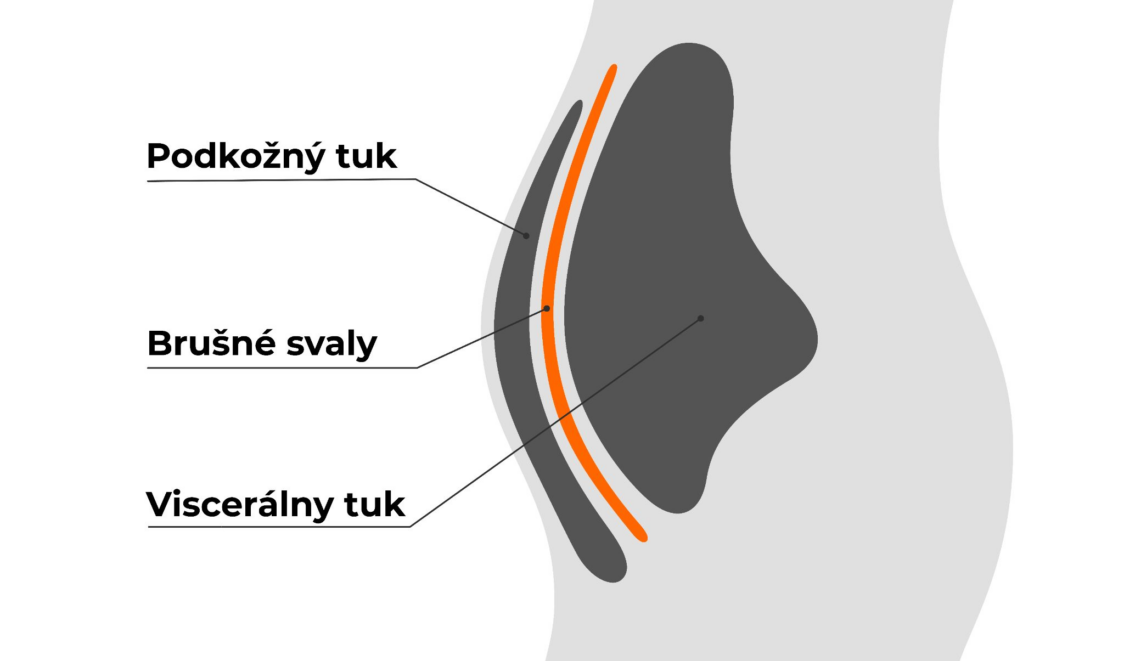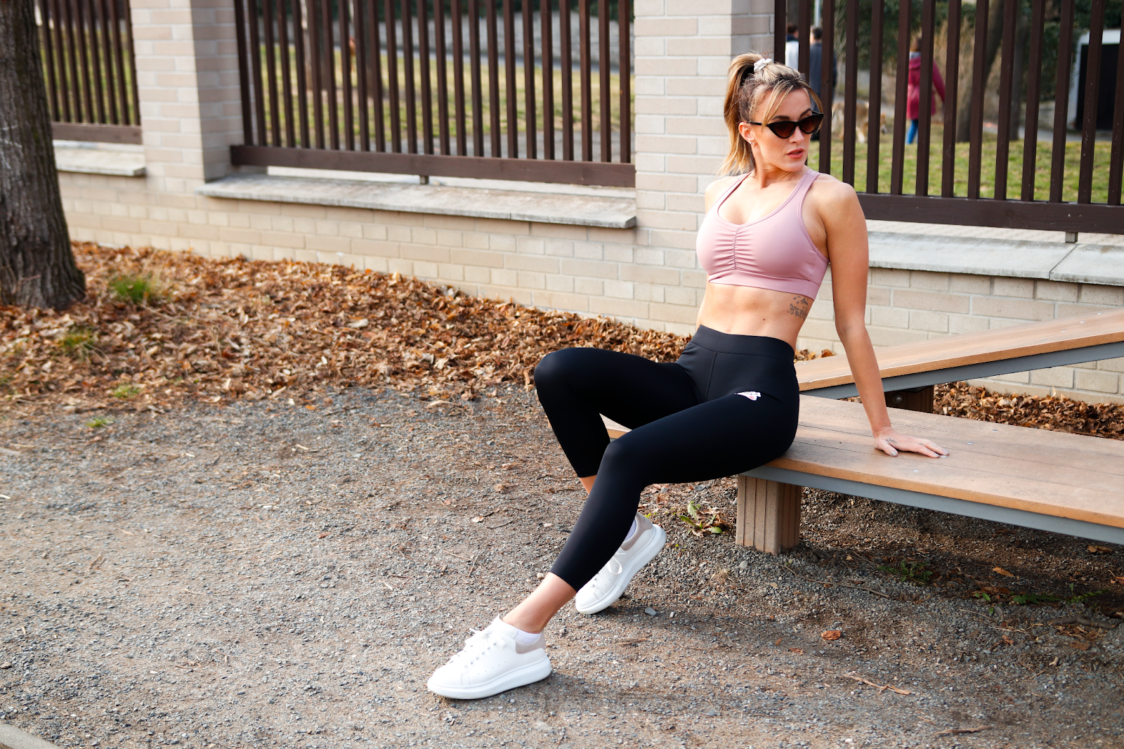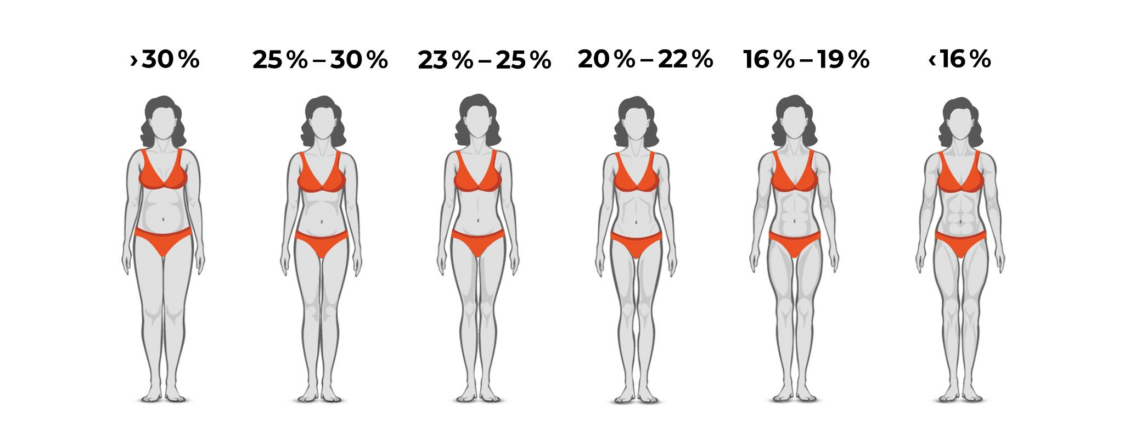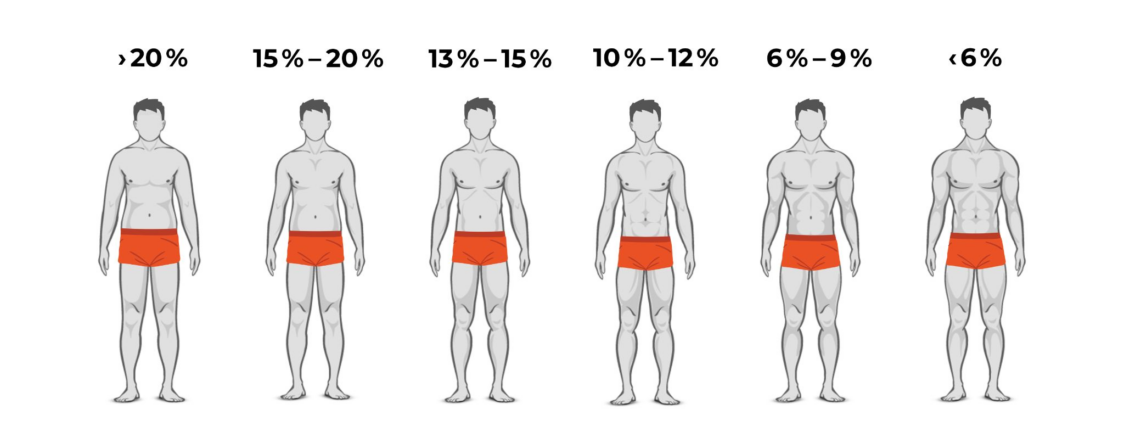Table of Contents
A chiselled abdomen and six-pack is one of the goals of every fitness enthusiast. With the vision of visible and toned abdominal muscles, some train them daily and count sit-ups relentlessly. However, you may be surprised to know that the success milestone of a sculpted abdomen lies elsewhere. Although exercising this part of the body is important, the six-pack is only visible when it is not obscured by a thick layer of fat. It is the proportion of body fat that will determine how visible your abdominal muscles will be and whether you will achieve your dream six-pack.
Is a chiselled six-pack a symbol of a healthy body?
A chiselled abdomen with a visible six-pack has become a sort of symbol of fitness and a healthy lifestyle. Social media regularly presents us with photos and videos of people who are in the fitness field on a daily basis, and many of them actually have bricks on their abdomen. This also helps us to build the idea that we will only be fit if we achieve it too.
However, it may still surprise some people that chiselled abs and a six-pack may not be synonymous with a healthy body. In fact, the six-pack will only be visible when you achieve a significantly low amount of body fat. Getting there, however, is challenging and often has nothing to do with a healthy approach to your body. Alternatively, when the goal is also to be kind to your health, it requires a great deal of commitment and a strict regimen. You have to lose weight overall, because it is impossible to target the areas from which the body will shed fat.
To sculpt your abdominal muscles is definitely achievable. For some, however, it is easier, but for others it may be on the verge of what is healthy and beneficial. That’s why it’s definitely worth thinking ahead to see if this is the right path for you.

What is body fat and what types of body fat do you have in your body?
Body fat consists of triacylglycerols (glycerol with three fatty acids attached) which are stored in fat cells (adipocytes). The adipose tissue composed of these cells is hidden under the skin and forms the so-called subcutaneous fat or wraps around your internal organs in the form of visceral (intra-abdominal) fat.
- Visceral (intra-abdominal) fat is found in the abdominal cavity, around the organs and primarily serves as their protection. However, if its proportion is too high, it becomes a risk factor for the development of diseases such as type 2 diabetes or heart disease. Although this fat is hidden in the abdominal cavity, it is not difficult to estimate when you already have an excess of it. This is because it is typically manifested by an oversized waist circumference. [10]
- Subcutaneous (under the skin) fat is a little less hidden from your eyes. In fact, it’s stored right under your skin and you see it in the form of unpopular tangible fat deposits that sometimes prevent you from getting into your favourite garments. It is the subcutaneous fat that also covers your abdominal muscles and prevents them from revealing themselves. Compared to visceral fat, excess subcutaneous fat is, to some extent, mainly an aesthetic problem. However, when it exceeds a certain threshold (or, conversely, when you have too little of it), it brings with it numerous negative health consequences.

What are the functions of body fat?
As unbelievable as it may seem, nature didn’t give you body fat just to complicate your life and predestine you to perpetual attempts at weight loss. Fat has important functions in the body, and in certain amounts you absolutely need it in order to survive.
- Fat serves as the main reservoir of energy that you can draw on when needed.
- It also provides important thermal and mechanical protection for your internal organs.
- Adipose tissue also produces hormones that affect hunger and satiety or are involved in the production of sex hormones. [12]
- It also affects the function of the immune and nervous systems and plays a major role in, for example, the sensitivity of cells to insulin. [8]
- At the same time, fat-soluble vitamins (vitamins A, D, E and K) are stored in fat. [4]
You might be interested in these products:
What affects the amount of fat in the body?
The amount of fat you have doesn’t just depend on how much you exercise or how well you eat. There are other factors at play, and you can’t fool yourself about their influence.
- Genetics also plays a role in how fast your metabolism is or how efficiently and where you store body fat. Since each of you has genes that are mixed differently, your natural body composition or fat distribution depends on it. Thus, some people store more fat on their abdomen, others store more on their thighs or hips, and you can’t control these predispositions. [3]
- Gender has an impact on body composition and body fat distribution. Men naturally have a lower proportion of adipose tissue than women. And when their body does store fat, it often manifests itself in the abdominal area. Women, on the other hand, are more likely to store excess fat in the lower part of the body, typically the buttocks and thighs. [4]
- The amount of fat also depends on your age. The older you get, the more fat your body naturally stores as your metabolic rate slows down. However, the fact that over time many of you will become less physically active and so your energy expenditure decreases which also plays a big role. [4]
- Hormones play an important role in your body weight and body composition. For example, we are talking about hormones that signal hunger (ghrelin) and satiety (leptin). Thyroid hormones that influence the metabolic rate or the stress hormone cortisol are also important. The cortisol can increase appetite or promote fat storage in the abdomen. [4]
- Of course, diet and physical activity have a huge impact on how much body fat your fat stores hide. These are the most important determinants of the balance between energy intake and expenditure, which in turn determines whether you gain weight, lose weight or maintain it.
- Sleep is an often neglected factor that affects your fat stores. In fact, lack of sleep is associated with a higher body weight, which is why you should all aim for 7–9 hours of sleep a day. [4,7]
It’s no coincidence that getting enough quality and long enough sleep is considered the best fat burner. Why this is so and what else sleep helps with can be found in our article Sleep: The Most Effective Energy Booster and Fat Burner.

How do you measure body fat?
Looking in the mirror, you can only estimate the proportion of body fat in your body. However, when you want to know more precise information, you need to measure the amount. How to do this?
- By measuring waist circumference, you can estimate what proportion of body fat you have. For example, the waist circumference of a young man between 75 and 83 cm may correspond to about 15-20% body fat. [5]
- You can obtain slightly more accurate information when you use a fat calliper to determine the amount of fat. Thanks to this, the percentage of body fat can then be estimated.
- Measuring body composition using a bioimpedance scale (which measures the electrical conductivity of different body tissues) will give you information about what proportion of muscle mass, fat and other information you have. Most often you will come across the InBody or Tanita scales, for example. These tools will give you fairly good results about your body composition.
- Methods such as densitometry or DEXA (dual X-ray absorptiometry) can provide the most accurate information. However, the average person will not come across these, as they are mainly used for research purposes. [9]
What is a healthy body fat percentage for men and women?
1. Healthy amount of body fat in women
Although there is no one-size-fits-all recommendation, based on various sources, a healthy proportion of fat mass for a woman is in the range of 20-30%. Body fat above 30% is considered overweight, while values above 35% are considered obese. [2,13]
Lower values are typical for female athletes and women who have their diet and exercise regimen well under control. It may not be healthy for the average woman to try to achieve such a low-fat percentage. [2,13]

What are the risks of too little body fat in women?
It is very difficult to achieve an amount of fat significantly lower than this lower limit. It requires long-term significant dietary restriction and a pretty demanding comprehensive training plan. This often results in too low a caloric intake and at the same time a very high energy expenditure, which can lead to so-called low energy availability. This is when you subtract the energy expenditure during sport from the daily caloric intake and you get a value of less than 30 kcal/kg. [1]
The problem is that low energy availability is commonly accompanied by health problems, which together are hidden under the term female athletic triad. These are menstrual dysfunction and low bone density. At the same time, they carry with them many other problems, such as a higher risk of injury, weakened immunity, reduced thyroid function or a higher risk of cardiovascular problems. In addition, the condition can be associated with psychological problems such as anxiety or depression. [1,11]
Of course, it is not the rule that a woman with a low body fat percentage is automatically faced with low energy availability and related problems. However, this is a very common phenomenon, so it is advisable to keep this in mind when trying to lose weight and achieve a toned body.
More about the female athletic triad can be found in our article How to Fight Menstrual Loss and Other Symptoms of the Female Athletic Triad?
2. Healthy amount of body fat in men
Men naturally have a lower amount of fat mass than women. Based on research, a fat percentage of about 10-20% is considered optimal for them. Values above 20% are considered overweight, and a fat percentage above 25% is considered obese. [2,6,13]
Even for men, lower numbers are typical for athletes, especially in aesthetic sports such as fitness and bodybuilding, where a low fat percentage is a prerequisite for success. For the average male who does sport for pleasure and health, it is probably pointless to aim for such low fat as it requires a lot of effort and restriction. [13]

Ranges of body fat in men and women
Women | Men | |
|---|---|---|
| Borderline low body fat % | < 16 % | < 6 % |
| Markedly athletic and slender physique | 16 – 19 % | 6 – 9 % |
| Optimal range | 20 – 30 % | 10 – 20 % |
| Overweight | > 30 % | > 20 % |
| Obese | > 35 % | > 25 % |
How much body fat do you need in order to see your abdominal muscles?
You all have abdominal muscles, but how visible and sculpted they are depends on the amount of fat mass covering them. The less body fat you have, the more visible your dream six-pack is.
When are abdominal muscles visible in women?
- Above 30% fat: this is the proportion of fat mass at which we are already talking about being overweight. In this case, the abdominal muscles are completely covered by a layer of body fat.
- 25 – 30%: even in this case, the abdominal muscles are not yet visible. Although not overweight, the body has a visible layer of subcutaneous fat.
- 23 – 25%: at this phase, it is possible that signs of abdominal musculature appear, but only minimally.
- 20 – 22%: a figure with this percentage of fat is already more defined and the contours of the abdominal muscles are partially visible.
- 16-19%: a woman with this proportion of fat is slim, has an athletic figure and visible abdominal muscles.
- below 16%: this is a significantly low proportion of body fat with clearly defined abdominal muscles. At the same time, however, this amount of fat is usually associated with a very strict regimen and carries with it the risk of the problems already mentioned. In addition, it increases the risk of these. [13]

When are abdominal muscles visible in men?
- Above 20% fat: a man with this percentage of fat is overweight, so the abdominal muscles are not visible at all.
- 15-20%: in this case too, the abdominal muscles are covered by subcutaneous fat.
- 13 – 15%: typically, the upper abdominal muscles may be partially visible, while the lower ones are still hidden under a layer of fat.
- 10 – 12%: in this case, the abdominal muscles are clearly visible.
- 6 – 9%: a man with this percentage of fat, which is already quite difficult to sustain, will probably already have noticeably visible abdominal muscles.
- under 6%: at this amount of fat, the six-pack is visible, but very challenging to maintain such a figure. [13]

How can you achieve chiselled abdominal muscles?
As you can see above, a visible six-pack requires a significantly low body fat percentage. Often it has to be far beyond what is generally considered to be an athletic and lean physique. It is commonly that last instance that falls short of the “perfect” physique, but requires a disproportionate amount of effort.
Your diet and training plan must be strictly adhered to, and to achieve this, it is often necessary to sacrifice sitting with friends or enjoying regular meals at a restaurant or café. Not to mention that such a strict regimen can bring with it health problems. Perhaps it’s worth thinking about whether that six-pack is worth it.
However, if you are determined to embark on this journey, it is important that you go about it the right way and with a healthy attitude towards your body. The following steps can help you do that.
- Focus on setting the right calorie deficit and amounts of protein, carbohydrates and fats. Our online energy intake and macronutrient calculator will help you calculate these values for you.
- Prepare a healthy diet with enough of all the nutrients that will be sustainable for you in the long term. Our article What is a Healthy Diet and How to Learn to Eat Healthy? will reveal how to do it.
- Pay particular attention to getting enough protein and fibre, nutrients that will help keep you satiated.
- Think through a training plan that includes both aerobic and strength activity. Since the goal is to have visible abdominal musculature, it is beneficial to include exercises for this area in your workout. Our article How to Create a Good Gym Training Plan Will Help You Build an Effective Plan?
- For inspiration on abdominal exercises, you can take a look at some of our articles:
- In addition to targeted workouts, don’t forget about regular activity throughout the day. Walking, going to and from the shops by foot, taking the stairs, or moving around while cleaning all contribute to your caloric expenditure.
- Once you have all of the above mastered, you can also call on nutritional supplements, such as various fat burners, to help you. These will not only help you lose weight more effectively, but also help you manage your calorie deficit better.
- Don’t forget to track and record your progress and interim results, for example, every two weeks. A classic scale, a regular body composition analysis on InBody or measuring the amount of fat with fat callipers can help you with this. Don’t underestimate taking regular photos of yourself or measuring your waist circumference. To make sure you don’t forget about these regular checks, set a specific time when you will do them. For example, Sunday morning after you wake up could be ideal.
For a more detailed guide on how to achieve your dream results, read our articles Lose the Belly and Get in Shape with Our Easy Guide or 9 Tips for a Sculpted Six-Pack.
What should you remember?
For athletes and fitness enthusiasts, a chiselled six-pack is often the icing on the cake that they would like to see on their athletic body. However, abdominal exercises are usually not enough. What defined abdominal muscles rely on is not a never-ending series of sit-ups, but the amount of body fat that covers them. However, in order for these muscles to show fully, it often requires a significantly strict regimen and weight loss to a degree that may no longer be sustainable or healthy in the long term. Thus, the dream of a sculpted abdomen is certainly achievable, but it is advisable to consider what your goal really is. Once you’ve got the hang of it, think about how to do it the smart and healthy way.
If you found this article interesting and useful, don’t forget to share it with your friends and loved ones.
[1] ARETA, J.L. et al. Low energy availability: history, definition and evidence of its endocrine, metabolic and physiological effects in prospective studies in females and males. – https://pubmed.ncbi.nlm.nih.gov/33095376/
[2] BRAY, G. et al. AACE/ACE Position Statement on the Prevention, Diagnosis, and Treatment of Obesity (1998 Revision). – https://www.academia.edu/21704685/AACE_ACE_Position_Statement_on_the_Prevention_Diagnosis_and_Treatment_of_Obesity_1998_Revision_
[3] BURKE, L. Clinical Sports Nutrition.
[4] DUYFF, R.L. Complete Food & Nutrition Guide. . New York: Academy of Nutrition and Dietetics, 2017. ISBN 978-0-544-52058-5.
[5] FLEGAL, K. et al. Comparisons of percentage body fat, body mass index, waist circumference, and waist-stature ratio in adults. – https://pubmed.ncbi.nlm.nih.gov/19116329/
[6] GALLAGHER, D. et al. Healthy percentage body fat ranges: an approach for developing guidelines based on body mass index. – https://pubmed.ncbi.nlm.nih.gov/10966886/
[7] HIRSHKOWITZ, M. et al. National Sleep Foundation’s updated sleep duration recommendations: final report. – https://pubmed.ncbi.nlm.nih.gov/29073398/
[8] IBRAHIM, M.M. Subcutaneous and visceral adipose tissue: structural and functional differences. – https://pubmed.ncbi.nlm.nih.gov/19656312/
[9] KURIYAN, R. Body composition techniques. – https://www.ncbi.nlm.nih.gov/pmc/articles/PMC6366261/
[10] POWELL-WILEY, T.M. et al. Obesity and Cardiovascular Disease: A Scientific Statement From the American Heart Association. – https://www.ahajournals.org/doi/full/10.1161/CIR.0000000000000973
[11] WASSERFURTH, P. et al. Reasons for and Consequences of Low Energy Availability in Female and Male Athletes: Social Environment, Adaptations, and Prevention. – https://www.ncbi.nlm.nih.gov/pmc/articles/PMC7483688/
[12] Adipose Tissue (Body Fat): Anatomy & Function. – https://my.clevelandclinic.org/health/body/24052-adipose-tissue-body-fat
[13] How to Get Lean and Is It Really Worth the Trade-Off? | Precision Nutrition. – https://www.precisionnutrition.com/cost-of-getting-lean


Add a comment